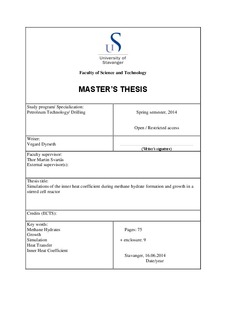| dc.description.abstract | In the thesis presented in this paper, simulations have been performed in order to investigate the inner heat coefficient of a hydrate-testing cell as a function of varying stirring rates, initial water amounts, and testing temperatures.
The model used in the simulation is based on heat,-and energy balance, where the inner heat coefficient is estimated as a result of the measured temperatures, and temperature differentials between the inside of the testing cell, and the cooling bath surrounding the cell. The testing conditions were varied in a range from 6-8°C, and 50-100 ml initial water, with stirring rates at 500, 700, and 1200 rpm. For each case, three to four experiments were performed, resulting in comparable data to find any differences. The assumption was that during close to identical test procedures, the values for the inner heat coefficient should remain within certain value-ranges.
The simulations were based on the initial hydrate growth phase, called region 1, which is defined as the domain for first visual hydrate formation, where gas flow increases drastically. The starting point of each simulation was just before the gas flow exceeded 300-400 nml/min to ensure sure that the growth phase had started, and the nucleation phase was finished. The simulation lasted approximately two minutes after the maximum gas flow had been observed.
Each simulation resulted in two plots, where the first consisted of temperatures, and the other showed heat generation from the process, plotted against time-units applied for the simulation. The inner heat coefficient was found by retrofitting the simulated interior temperature, to the corresponding measured temperature. This was performed for 53 cases, where a trend seemed to emerge. As the stirring rate increased, the gas consumption increased, which meant that within the roughly three minute simulation period, the total amount of hydrates formed increased with the stirring rate. The stirring rate seemed to have a dominant effect on the inner heat coefficient, as the lowest hi-values were found for the 1200-rpm case in a majority of the trials. This is contrary to the prevailing hypothesis, where the Reynolds number and turbulence was thought to determine the convection inside the cell, and therefore increase the inner heat coefficient, as stirring rate increased. | nb_NO |

